Victoria Falls is known as the 'smoke that thunders' and is among the best waterfalls in the world. Learn why Zimbabwe is such a beautiful stop on our Southern Africa tour with an excellent write up shared with us by Dale of the Maritime Explorer.
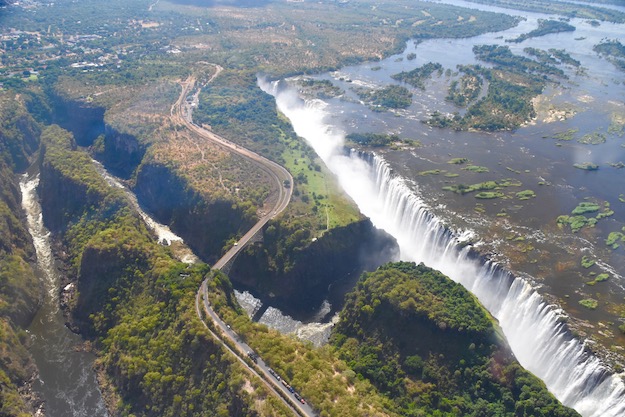
Victoria Falls Tour With Adventures Abroad
Alison and I have just completed a 12 day tour of Namibia with Canadian tour company Adventures Abroad. Here’s a post giving you all the reasons why this is a must-do trip if you like to get off the beaten track and experience a country that is only now coming into its own as a tourist destination.
However, unlike most of our group we are not headed back to the North American winter, but rather onward to Victoria Falls and then Botswana. One of the great things about traveling with Adventures Abroad is that they offer their trips in such a way that you can add consecutive destinations if you want to.
For example, last year we explored Colombia and then Panama and almost at the last minute added on Costa Rica. On this trip we had the option of just doing Namibia or adding on Victoria Falls and Botswana. For us it was a no brainer. Who doesn’t want to see Victoria Falls? So let’s go!
Zimbabwe
In case you don’t know, Victoria Falls on the Zambezi River is shared by two countries, Zambia on one side and Zimbabwe on the other. For our short visit we will be visiting the Zimbabwe side and staying just outside the town of Victoria Falls. I must say that when I first read the itinerary and saw that we would be going to Zimbabwe it bought both a sense of excitement and a little bit of trepidation.
This country which was once the ‘Breadbasket of Africa’ for its abundance of agricultural produce and resources was now the basket case of Africa. Under liberator turned dictator Robert Mugabe, the economy was essentially destroyed, the currency degraded to levels only seen in post WWI Germany, life expectancy lowered and poverty and even starvation prevalent. Unfailingly, until his ouster in 2017, he blamed the country’s decline on colonialism, imperialism and ‘the whites’. This had the result of driving out most of the pre-independence white population.
So I was just a bit leery of how white tourists would be treated in Zimbabwe and whether or not we would come face to face with the well documented problems of this African nation. I was also interested in finding out if things had improved since Mugabe was replaced by Emmerson Mnangagwa.
My first surprise about Zimbabwe came as we taxied toward the Victoria Falls International Airport after the flight from Windhoek on Air Namibia. Expecting a run down aerodrome, instead I saw a gleaming new terminal. Obviously things had not fallen apart as precipitously as the western media would have us believe.
However, the reason lies not in Zimbabwe, but in China which provided the money for the upgrading of the airport. This follows a pattern that China has been using throughout Africa where its influence now far outstrips the United States and the former colonial powers. Whether in the long run this will be a boon or a boondoggle remains to be seen.
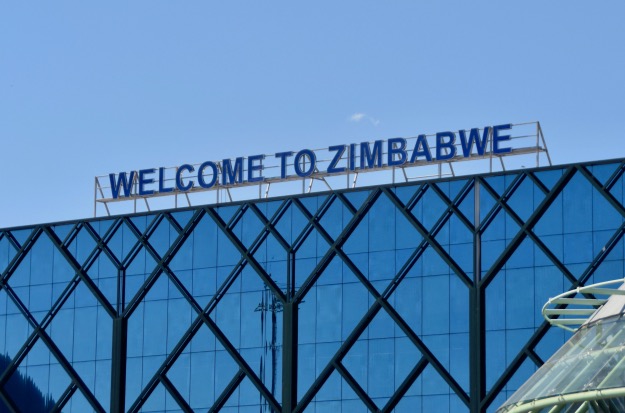 Welcome to Zimbabwe
Welcome to Zimbabwe
We had been warned in advance that obtaining a visa which we had to do at the airport could be a time consuming affair. There were five of us, all Canadians, in our small group and we quickly learned that the price of a visa for Canadians was $75 US, payable only in cash.
I don’t know what Canada does to piss off other countries because we think everybody loves us, but this is the highest fee for any country in the world. Americans pay only $30, while most commonwealth countries don’t even need a visa.
The customs agent took our five passports and the cash and disappeared for about twenty minutes which gave me time to look over some of the old travel posters on the walls. Then he was back with our passports stamped, the money gone and we were free to leave.
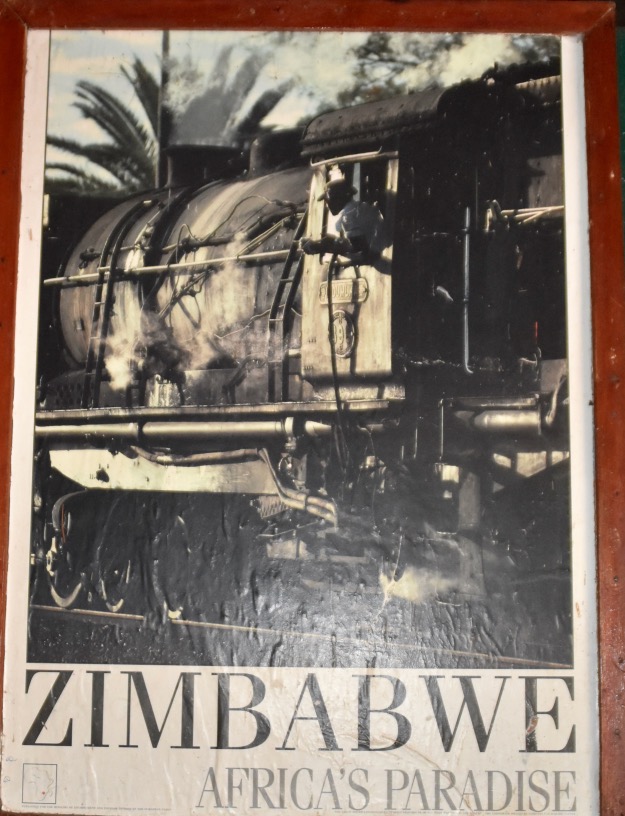 Africa’s Paradise
Africa’s Paradise
Waiting for us outside was our Zimbabwean guide Wengaji Nhau and his trusty assistant Loma Tombara who took great care of us our entire time in Zimbabwe. Wengaji is the owner of Wenhau Safaris and he has been guiding tourists around Zimbabwe for over twenty years and has been Adventures Abroad’s agent in that country for almost as long.
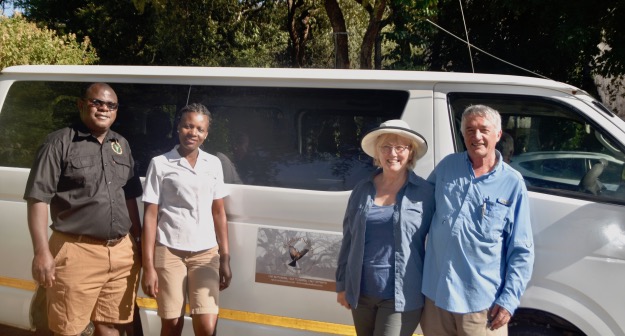 With Wengaji Nhau & Loma Tambara
With Wengaji Nhau & Loma Tambara
A’Zambezi Lodge
Despite the fact that Victoria Falls is Zimbabwe’s largest tourist attraction, there is only one lodge actually fronting on the Zambezi River on the Zimbabwe side and luckily that’s where we are staying. A’Zambezi Lodge has 83 rooms on two floors in an arcing curve that provides good views from any of them. I took this shot from a helicopter, about which more later in this post.
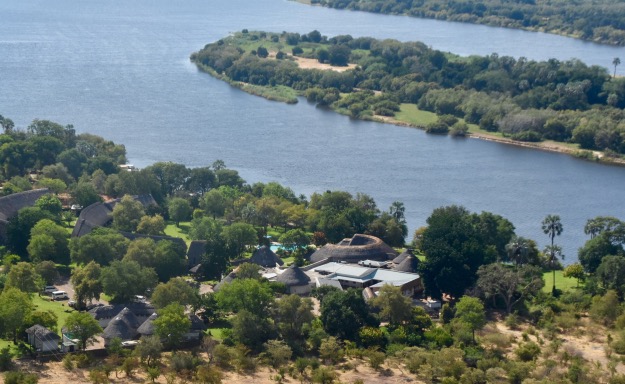 Aerial View of A’Zambezi Lodge
Aerial View of A’Zambezi Lodge
This is the reception area with a small waterfall reminding us why we were here.
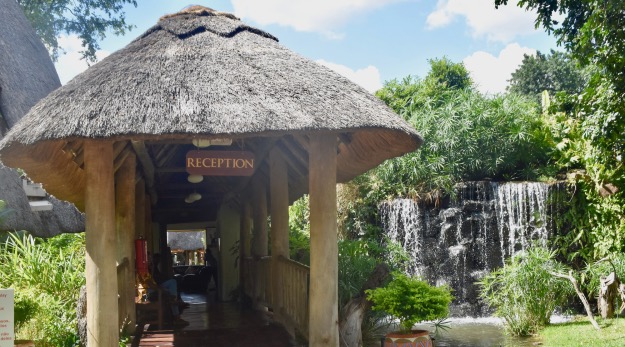 A'Zambezi Lodge Reception Area
A'Zambezi Lodge Reception Area
After checking into our rooms I did a quick inspection of the grounds which had at least one thing in common with the place we stayed in Etosha in Namibia – warthog lawn mowers. Like the ones at Etosha these warthogs were not in any way aggressive and entertaining to watch.
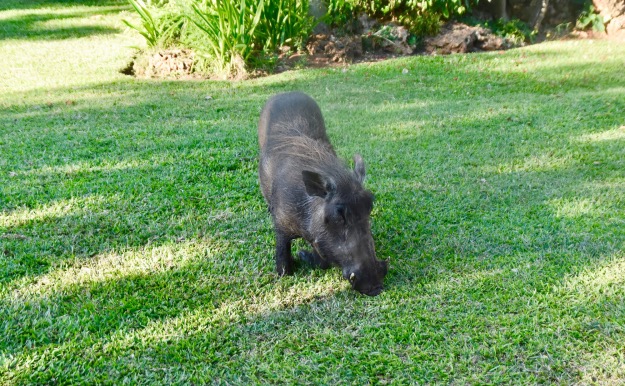 Zimbabwe Lawnmower
Zimbabwe Lawnmower
Even more entertaining were the antics of the vervet monkeys, especially the young ones. Whoever invented the expression “More fun than a barrel of monkeys” may have been watching this species.
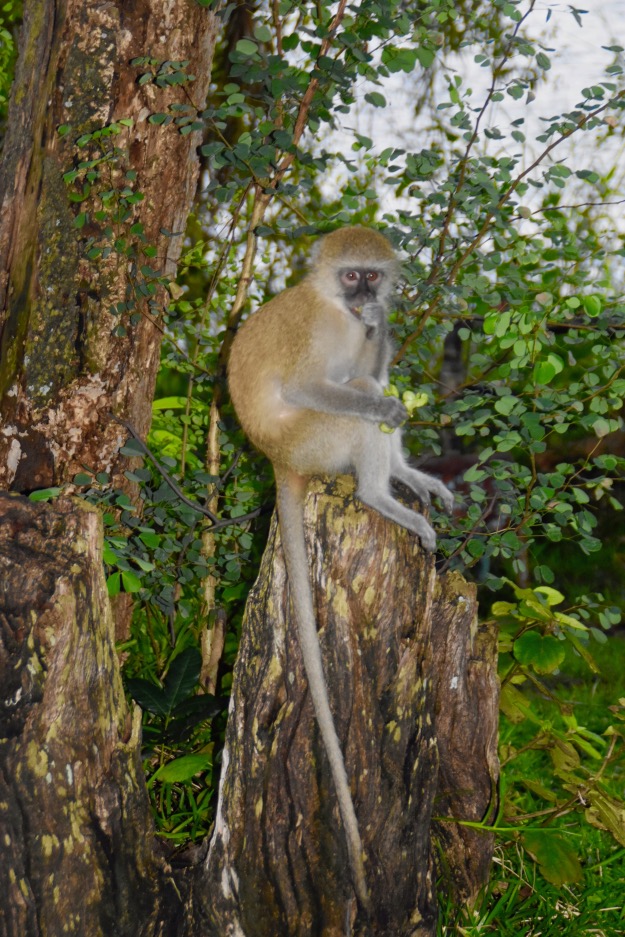 Vervet Monkey
Vervet Monkey
Also on the grounds was an open air bar.
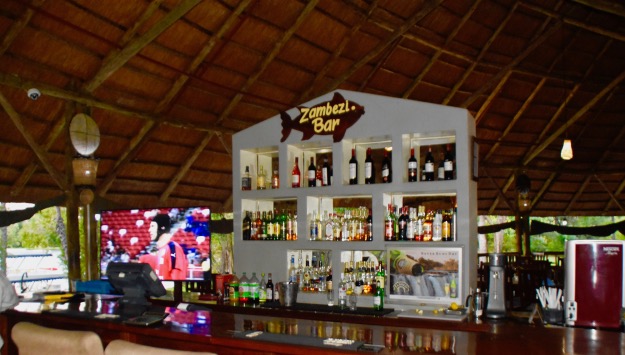 A’Zambezi Bar
A’Zambezi Bar
One thing Mugabe did not ruin in Zimbabwe was the national beer, Zambezi which, while not the best I had in Africa, was nonetheless a refreshing and pleasantly bitter lager.
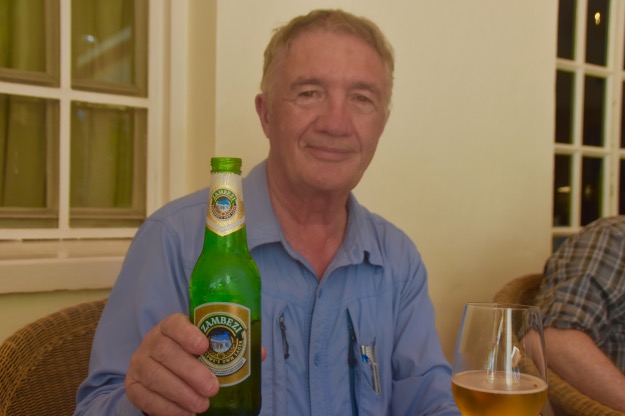 Zambezi Beer
Zambezi Beer
Zambezi River Cruise
After freshening up, we hopped into Wengaji’s van and drove almost right next door to a jetty and boarded one of a number of boats that were offering sunset cruises on the Zambezi.
It was a very pleasant evening with no wind and despite the fact we were not that far upstream from Victoria Falls, surprisingly little current. There is something inherently romantic and mysterious about the Zambezi River which rises in the heart of ‘darkest Africa’ and flows 1,600 miles (2,574 kms.) to the Indian Ocean. I honestly never really thought that one day I would be on a boat on this river, but here we are.
Almost immediately we come across the most dangerous animal in Africa – not the lion, leopard, elephant or hyena, but the hippopotamus. Over 500 people a year are killed by these ungainly looking creatures that are mean tempered and aggressive. Fortunately our boat is big enough not to worry about being capsized by these guys so we just stick out or tongues and give them the raspberry as we go by.
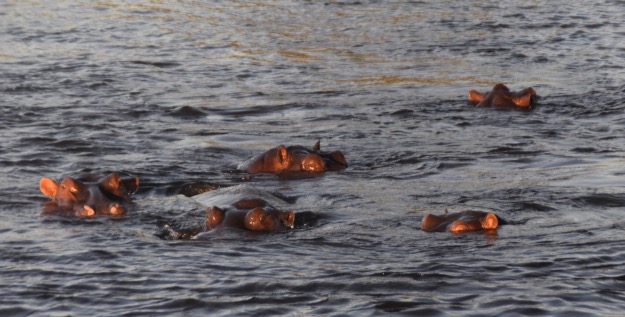 Hippos on the Zambezi
Hippos on the Zambezi
The openbill is one of Africa’s more unusual birds. It’s a member of the stork family with an enormous bill that it uses to catch and crush snails and mussels that are the mainstays of its diet.
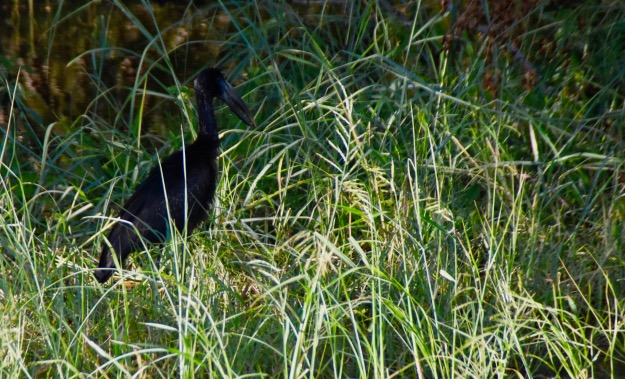 Openbill
Openbill
Another interesting bird is this African jacana, aka the Jesus bird because it seems to be able to walk on water.
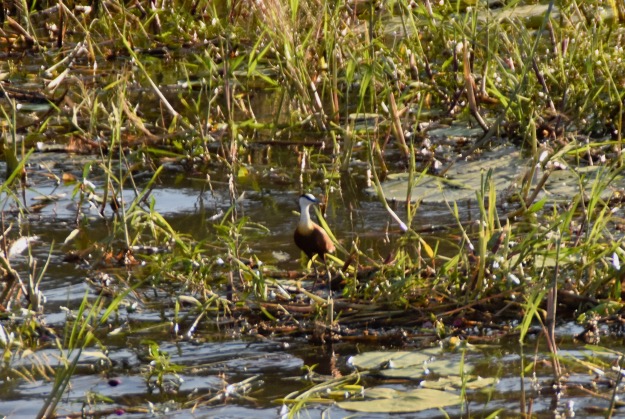 Jacana
Jacana
By now the sun is getting low on the western horizon and it’s time to return to shore for a late dinner.
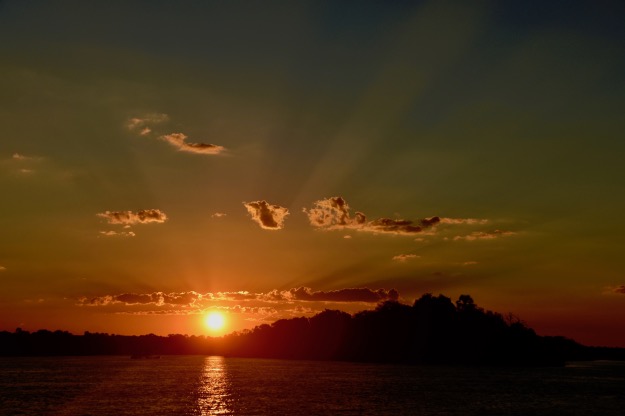 Zambezi Sunset
Zambezi Sunset
As we leave the boat I put some American dollars in this tip jar as the crew has been very generous with the gin and tonics. Back home this type of representation would be politically incorrect and verboten, but not in Zimbabwe apparently.
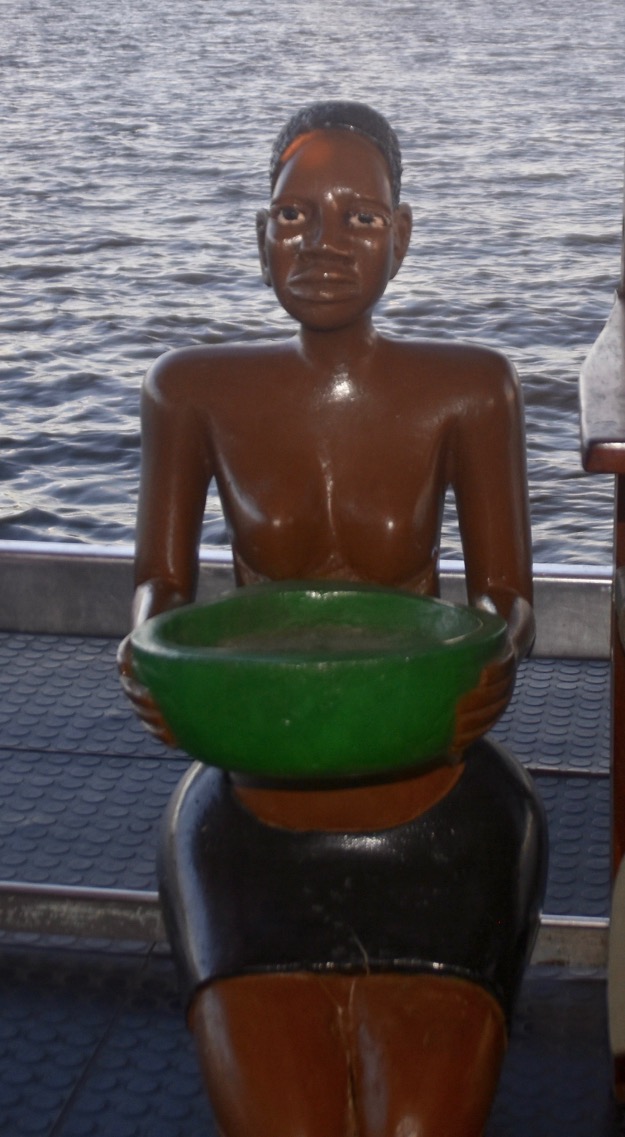 Tip Jar on the Zambezi
Tip Jar on the Zambezi
Back at the A’Zambezi Lodge there is quite a spread set out and I am torn between the warthog and the crocodile, settling for both. The warthog is very good, the croc tasting like the proverbial tough chicken.
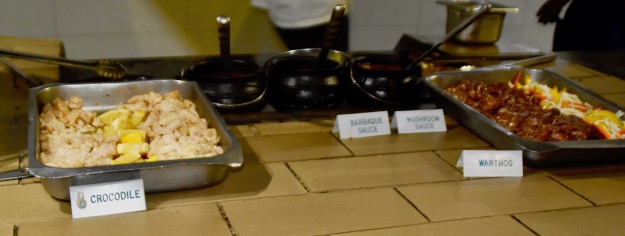 Crocodile or Warthog
Crocodile or Warthog
After finishing dinner we are entertained by a troupe of dancers from one of the local tribes. Each tribe (and yes that’s how they self-identify) has its own unique type of dance and manner of dress which reflects their traditions and beliefs. They genuinely seemed to enjoy entertaining the guests and I found nothing patronizing or demeaning in the manner they were portrayed.
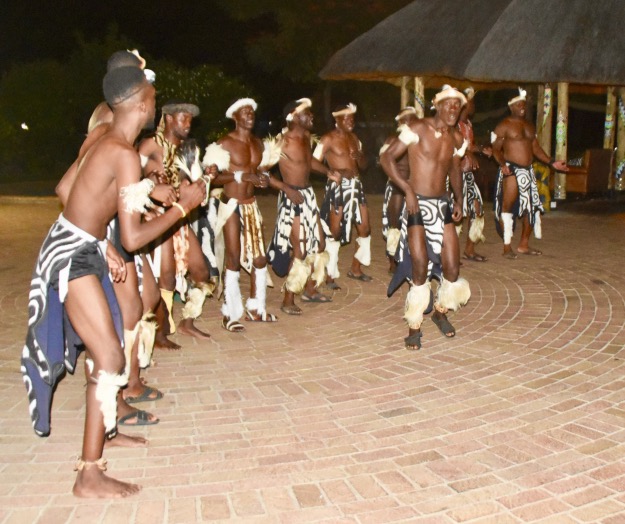 Zambezi Dancers
Zambezi Dancers
We went to bed with visions of Victoria Falls dancing in our heads. Tomorrow we would see one of the Seven Natural Wonders of the World.
Victoria Falls
Wen picked us up after breakfast and we were on our way to our Victoria Falls tour with one stop on the way. This is an at least 1,200 year old (some say it could be 2,000 years old) baobab simply called The Big Tree and it has been a traditional meeting point for Zimbabweans for centuries.
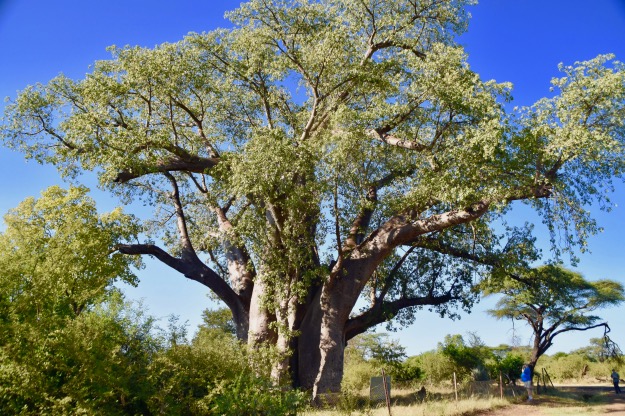 The Big Tree
The Big Tree
Nearby this massive bull elephant poked out from the bush, reminding us that you need to be aware of your surroundings at all times when outside your vehicle in sub-Saharan Africa.
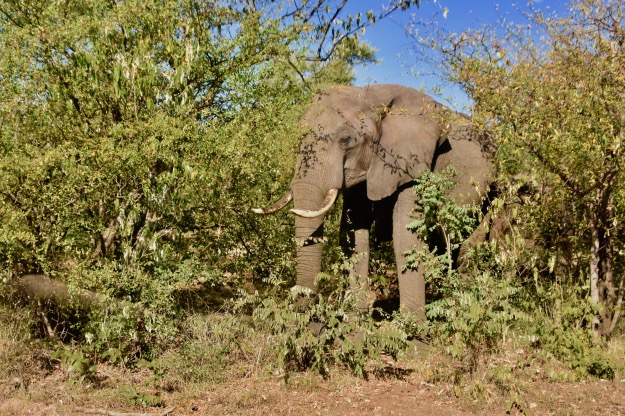 Bull Elephant Near Victoria Falls
Bull Elephant Near Victoria Falls
What is the largest waterfall in the world? Don’t ask me. Nobody seems to agree whether it’s total height, total volume or total length that matters the most. Victoria Falls doesn’t come in first in any of these categories.
At 108 metres (354 feet) it’s not even in the same league as Angel Falls in Venezuela at 979 metres (3212 feet). In terms of flow rate it’s less than 10% of Boyoma Falls (formerly Stanley Falls) in The Congo, but Boyoma doesn’t have a single drop over 5 metres (16 feet) – that’s pathetic.
Finally it’s outclassed in width by Khone Falls on the Mekong River in Laos by 10,782 metres (35,376 feet) to 1,708 metres (5,603 feet). So why is it so famous? Because it is the Goldilocks of all waterfalls – it has height, flow and width in a combination that none of its competitors, with the possible exception of Iguazú in South America, can touch.
I deliberately chose this trip to Victoria Falls to coincide with the time of year, February through early May, when the water volume is at its maximum. There’s nothing worse than visiting a famous waterfall and finding it almost a trickle.
The people who have been living in this part of Africa for millennia have always called the falls Mosi-oa-Tunya which translates into ‘The Smoke that Thunders’, a reference to the mist thrown up by the falls that is visible from miles away. I saw it as we flew in yesterday and now we are about to see it close up.
Victoria Falls is both a UNESCO World Heritage Site and a national park on both sides of the Zambezi so it has not been commercialized anywhere near to the extent of Niagara, although there are a ton of things to do other than just view the falls. But really, it is all about the falls so let’s go.
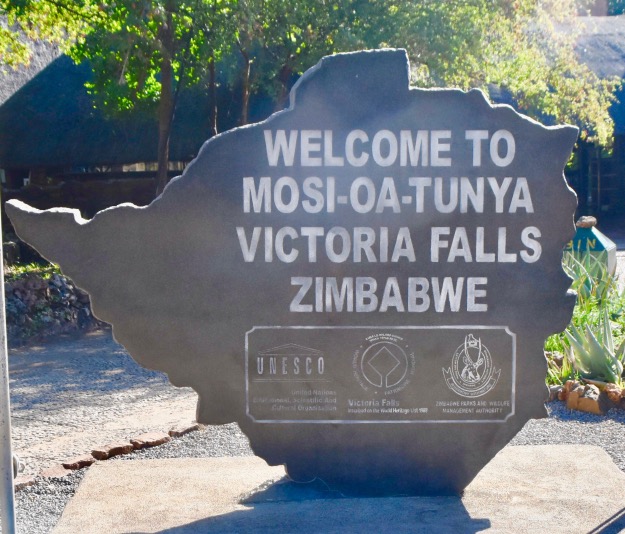 Welcome to Victoria Falls
Welcome to Victoria Falls
On the Zimbabwe side there is a path with numerous look offs that is the best way to view the falls. There is only one entry point which requires negotiating your way through the usual crowd of hawkers, drummers and dancers that frequent such entry points. However, they are nowhere near as aggressive as those you’ll find in many other places around the globe.
After paying our entry fees Wen gathers our small group around this map and explains the geology and history of Victoria Falls and route we will take to see it. He also tells us that we are all going to get soaked unless we wear waterproof ponchos. Alison and everyone else takes him up on this and buys a plastic poncho for a few bucks. Being the idiot I am, I don’t.
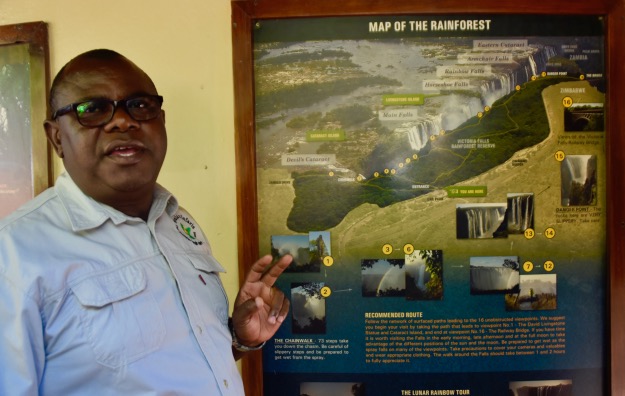 Wen Explains Our Route Around the Falls
Wen Explains Our Route Around the Falls
This is the path that leads to the western end of the falls.
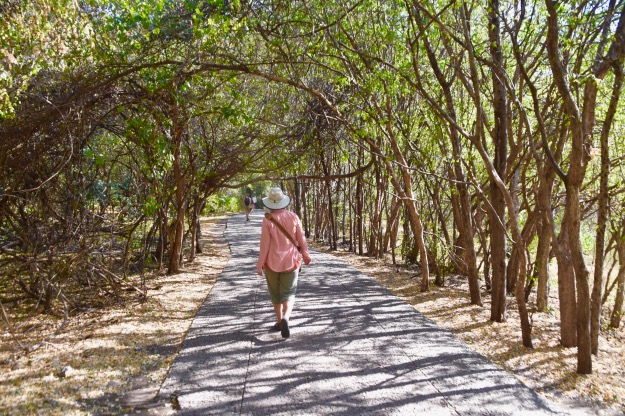 Alison Heading to the Falls Path
Alison Heading to the Falls Path
At the end of this path you come upon the famous statue of David Livingstone who is credited with ‘discovering’ the falls in 1855 even though millions of Africans knew about its existence for thousands of years. I always liked David Livingstone for his determination and will even though it was almost completely misspent.
As a missionary to the African tribes, his task of converting them to Christianity was spectacularly unsuccessful. Over the course of decades he converted exactly one person, his guide. However, as an explorer and ardent antislavery advocate he was much more successful and remains today one of the great heroes of the Victorian era when Britain truly did have an empire on which the sun never set.
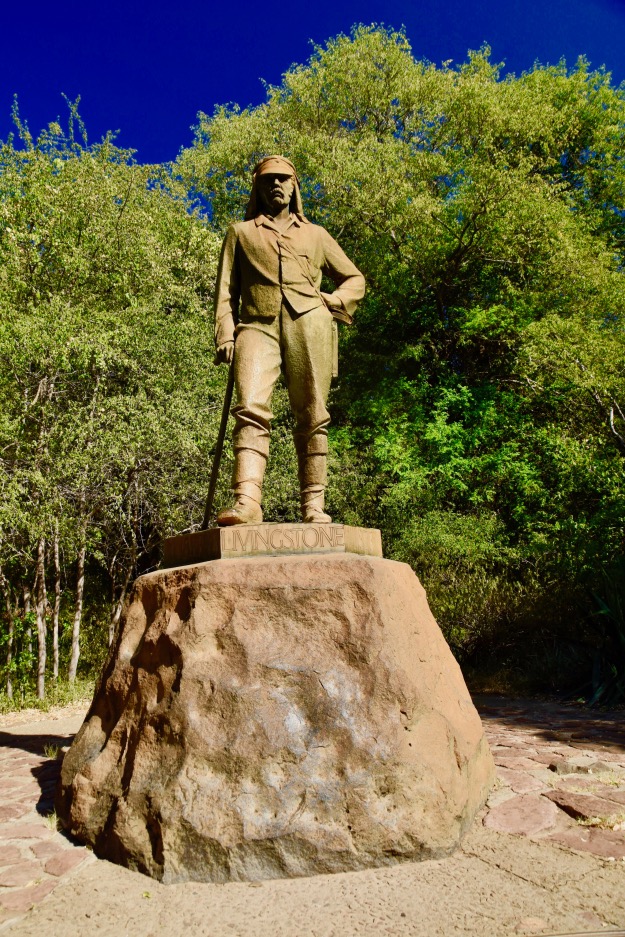 David Livingstone
David Livingstone
This is the first look at Victoria Falls, the Devil’s Cataract that is at the far western end of the falls and separated from the main falls by Cataract Island. On its own this would be a mighty sight, but it’s just a harbinger of what is to come. It also brings home the realization that Victoria Falls drops into a fairly narrow canyon and it’s not like Niagara where you can get a pretty good view of the entire falls from the Canadian side.
At Victoria Falls the only way to appreciate its magnificence is to walk from one view plane to the next, each offering a different perspective of the cascading waters.
As you continue along the path you get a better view of Devil’s Cataract and the perpetual rainbows for which Victoria Falls is justly famous.
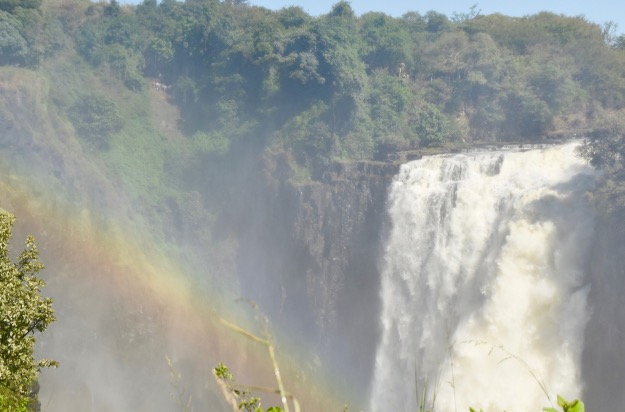 Rainbow at Victoria Falls
Rainbow at Victoria Falls
The path rises and you get one last and really good look at Devil’s Cataract.
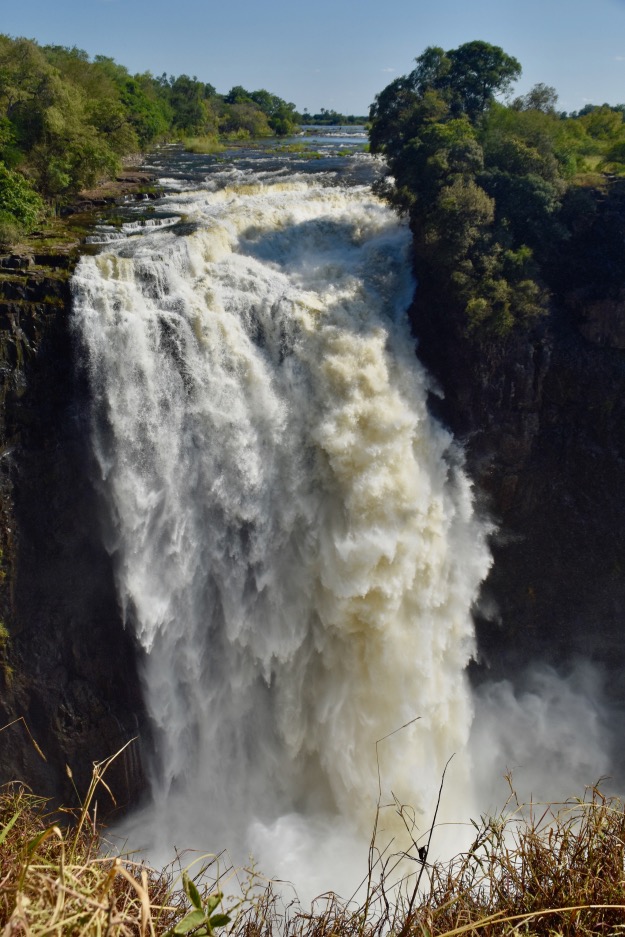 Devil’s Cataract
Devil’s Cataract
By now the roar of the falls is deafening and the mist that rises over one hundred feet above the falls comes into full view. Here is the main falls in all its splendour and glory, but these videos and the photo show only a fraction of it.
Standing on this spot, looking at Victoria Falls was truly one of the great highlights of a lifelong quest to explore as much of the world as possible. Many famous sights do not live up to their hype. Victoria Falls does.
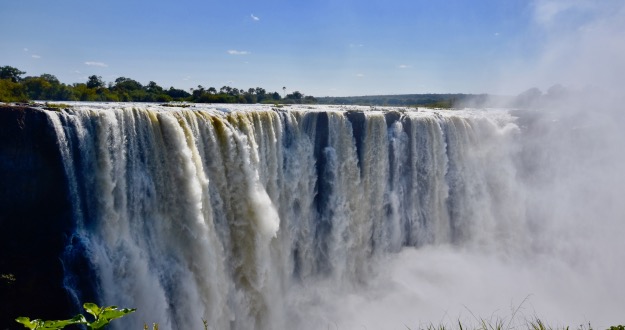 Victoria Falls
Victoria Falls
After this view point you enter the mist that Wen warned us about. Alison dons her poncho and I get soaked.
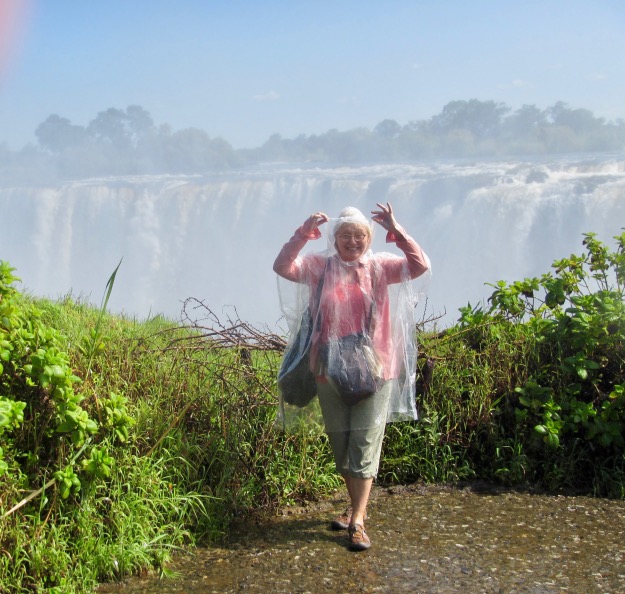 Not Getting Soaked
Not Getting Soaked
From here there are at least seven or eight more look offs, all spectacular but covered in mist so that without a waterproof camera it’s not advisable to try to take photos. All you’ll get is a gray monochrome anyway. It’s just the being there that matters.
Victoria Falls Hotel
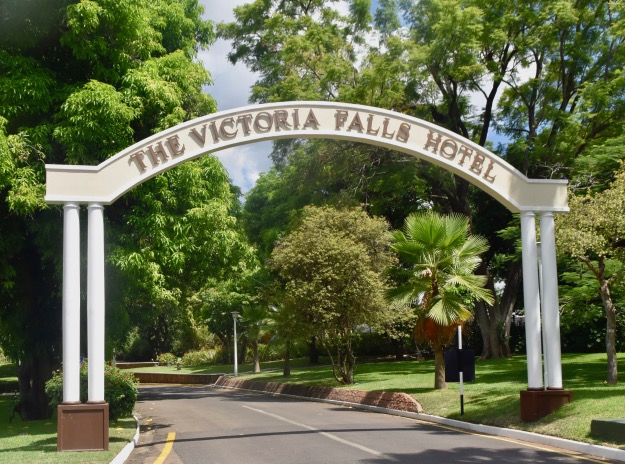 Victoria Falls Hotel Entrance
Victoria Falls Hotel Entrance
After spending about two hours at Victoria Falls we reassemble and Wen asks us if we’d like to have lunch at Victoria Falls Hotel, one of the famed luxury hotels of the African railway era. That’s a no brainer.
There is a guard armed with a rifle at a sentry booth near the entrance that Wen assures us is to deal with potential threats from hyenas and not humans which is weird because the hotel is literally right in the town of Victoria Falls. They must be pretty brazen.
This is the view from the terrace of the hotel and you can clearly see the mist from the falls in the distance.
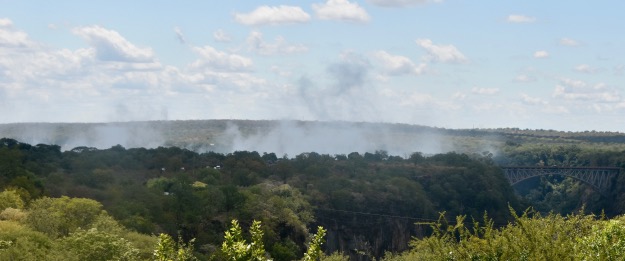 View from Hotel Terrace
View from Hotel Terrace
The Victoria Falls Hotel is a study in latter day elegance and pomp that I was surprised to see has survived intact the years of anti-colonialism under the Mugabe regime. There’s even a huge portrait of King George V still on display along with many more mementos from the days when Zimbabwe was still the colony of Southern Rhodesia and Cecil Rhodes was the de facto ruler.
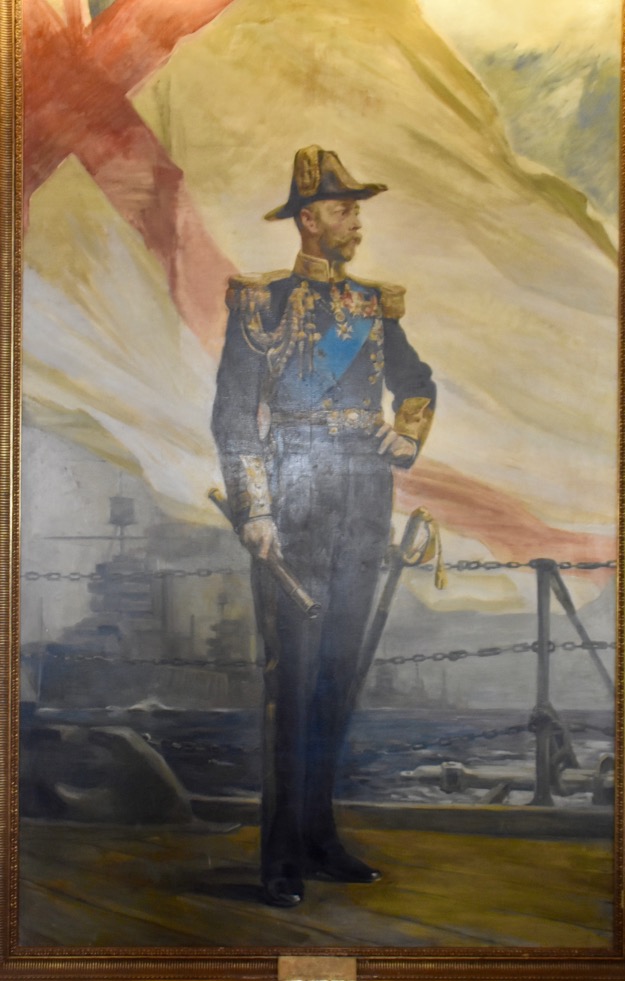 King George V
King George V
We had an al fresco lunch on Stanley’s Terrace and it was every bit as good as I expected and not that pricey. If you come to Victoria Falls don’t pass up a visit to this stately institution.
After lunch I took a stroll by myself into the actual town of Victoria Falls and came across a bunch of baboons who were having a picnic in a park, mingling with a number of layabouts.
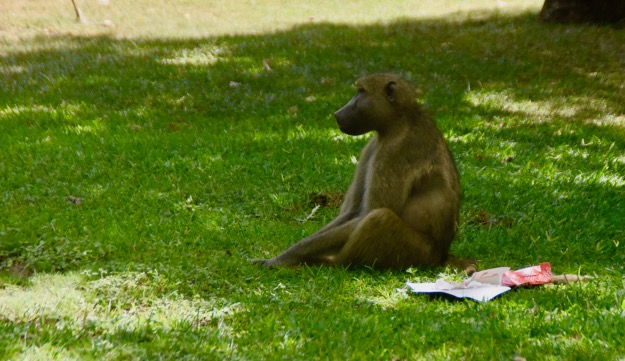 Picnicking Baboon
Picnicking Baboon
I didn’t stay long because I kept getting approached by young men wanting to sell me something. After a number of refusals, one guy made it clear that what they really wanted was American dollars and he offered to swap Zimbabwean dollars at ‘a very fair rate’ for 10 USD.
I suspect he thought I would not know that these Zimbabwean dollars have not been legal currency since 2015. Zimbabwe has no effective currency of its own and any hard currency is valuable just as long as it’s not their own. Thanks Robert Mugabe.
Victoria Falls Tour From The Air
There was one final adventure planned for Victoria Falls and after I returned to the group Wen delivered Alison and me to the Flight of Angels helicopter pad on the crest of a hill not far from A’Zambezi Lodge.
At $150 USD for a 15 minute helicopter ride and Victoria Falls tour it’s pretty pricey and I could see as one helicopter after another took off and landed that this was a very profitable business. But I very much doubt that on my deathbed I’ll be thinking “I wish I hadn’t spent that money on a helicopter ride in Victoria Falls”. More likely the opposite, if I’d passed up the opportunity.
We had been advised on signing up for this trip that helicopter rides over Victoria Falls could be arranged with advance notice and Wen had us reserved for a 3:00 PM flight. After paying, we each had to do a weigh in on a scale like those used for boxers. Alison said she’d kill me if I posted a picture of her weigh in so in the interests of domestic harmony I won’t.
This is Alison headed for the helicopter where she got to sit up front with the pilot while I shared the back seat with two guys from Australia.
 To the Helicopter
To the Helicopter
After adjusting our harnesses and putting on head sets we were off. It might only be fifteen minutes, but what great minutes those were as we made several passes above the falls. I’ll let the photos do the rest.
This one gives a much better idea than you get from the ground of how narrow the canyon is and how the Zambezi has carved a tiny gap through the cliffs on the downriver side, which is exactly where the famed bridge built by Cecil Rhodes crosses from Zimbabwe to Zambia.
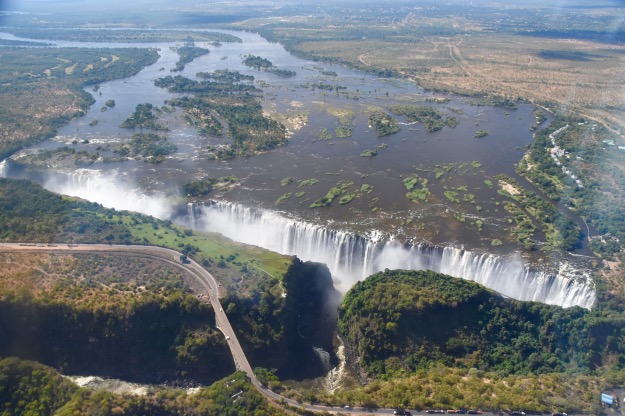 Victoria Falls
Victoria Falls
In this photo you can see how the canyon makes an acute hairpin turn not far from the bridge.
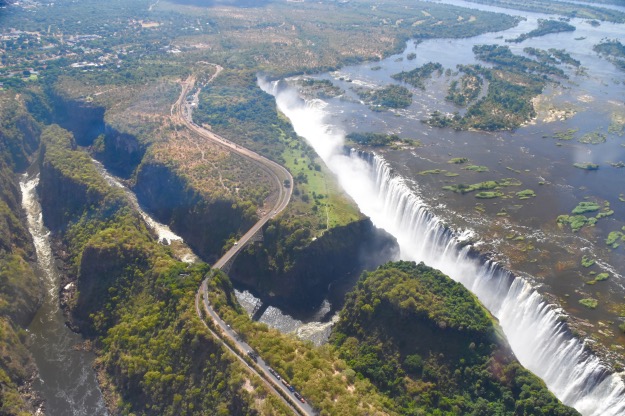 Victoria Falls, Bridge & Canyon
Victoria Falls, Bridge & Canyon
In this photo we are much closer to the falls and you can see just how precipitous the plunge really is. That’s Devil’s Cataract at the bottom of the photo.
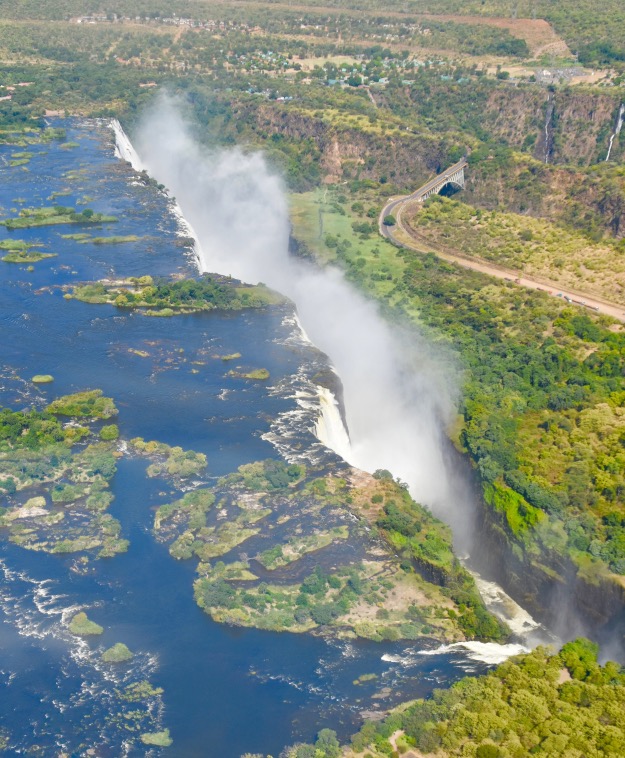 Victoria Falls from Above
Victoria Falls from Above
This is a closer look at Devil’s Cataract.
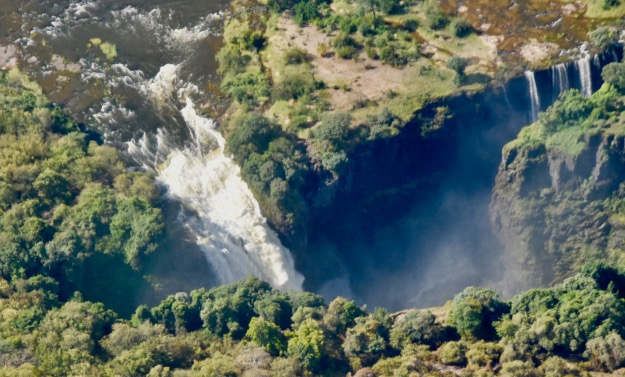 Devil’s Cataract
Devil’s Cataract
This is a closer look at the main falls.
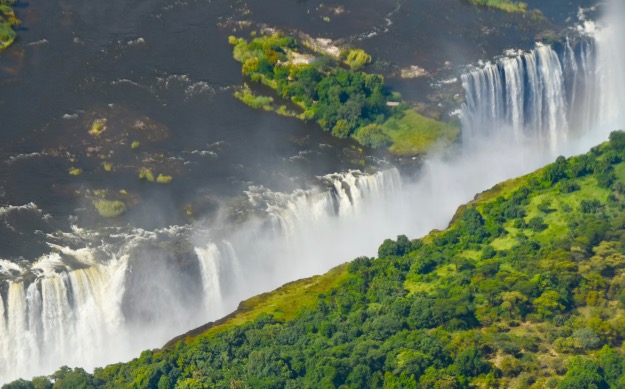 Aerial View of Main Falls
Aerial View of Main Falls
A closer look at the bridge. That white thing in the middle is a platform used by bungee jumpers.
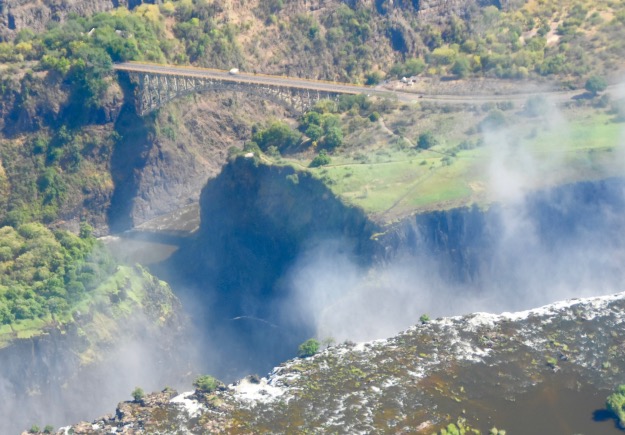 Bridge & Falls
Bridge & Falls
For this shot the pilot took the helicopter into a bit of a dive that for a second had me thinking we were going right into the falls.
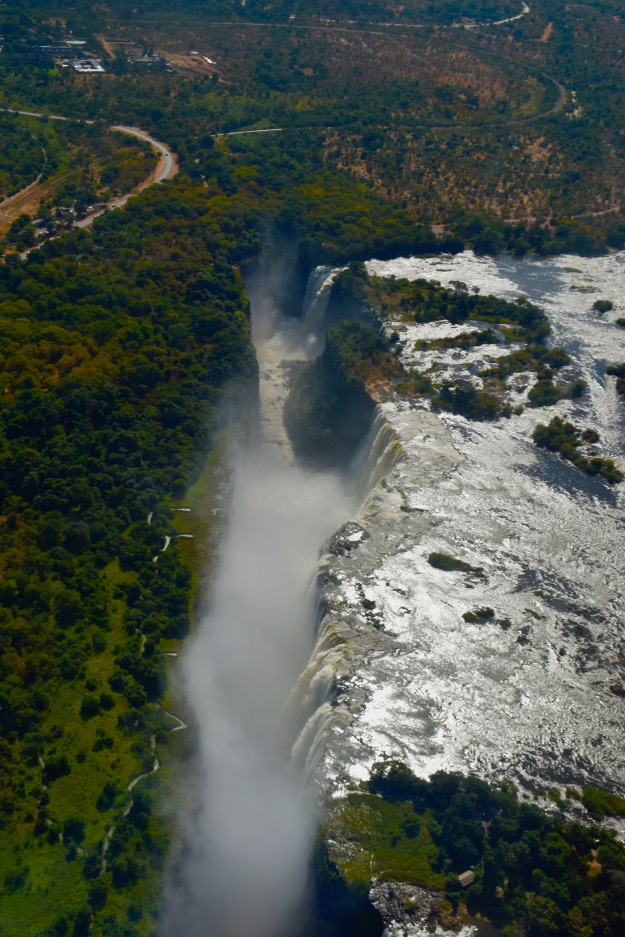 Directly Overhead
Directly Overhead
This is the Zambezi Canyon as the river makes its way east to eventually drain into the Indian Ocean.
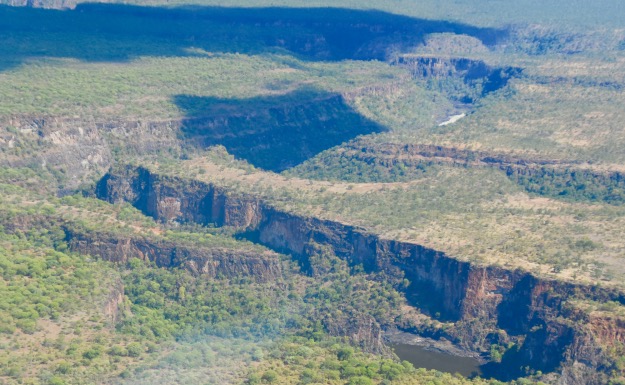 Zambezi Canyon
Zambezi Canyon
Before returning to base the pilot took us upriver which is how I got the aerial shot of A’Zambezi Lodge and this one of Elephant Hills Golf Course.
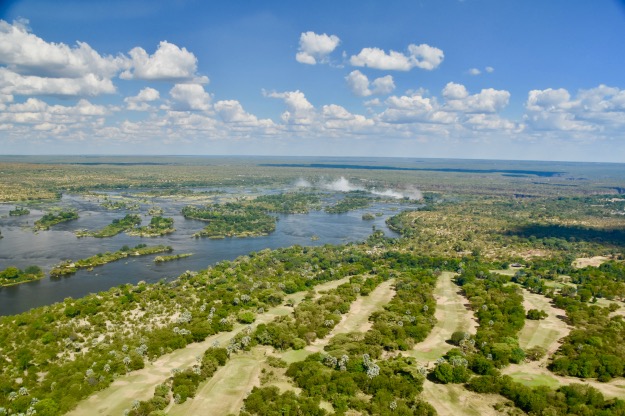 Elephant Hills Golf Course
Elephant Hills Golf Course
Unless you are really terrified of flying or severely cheap, a helicopter ride over Victoria Falls should be a given for any trip to the area.
We had a second night of great food and drink followed by a different set of tribal dancers and then it was time to start a new adventure on the Chobe River on the border of Namibia and Botswana. I hope you’ll come along.
Many thanks again to Dale of The Maritime Explorer for allowing us to share his insights. Learn more about our Zimbabwe tours.